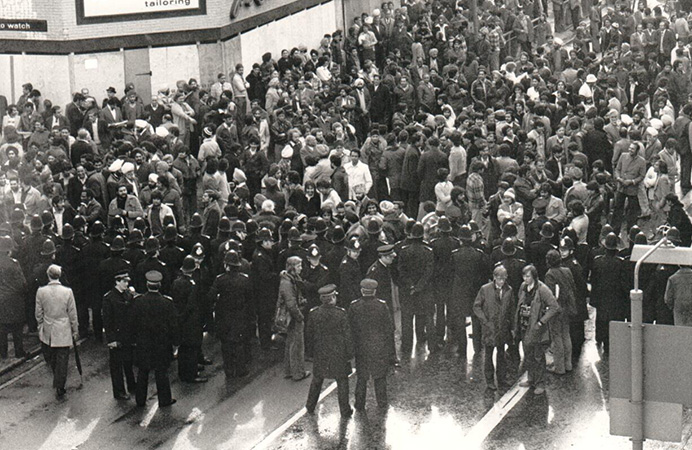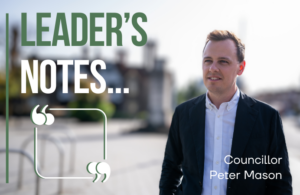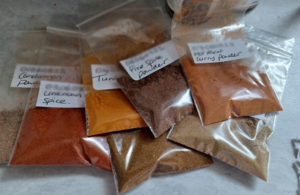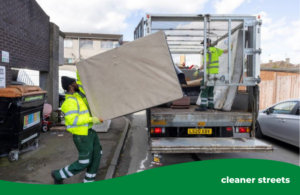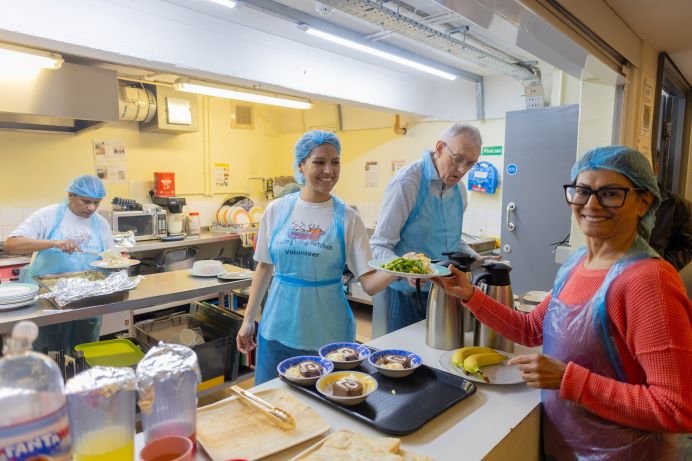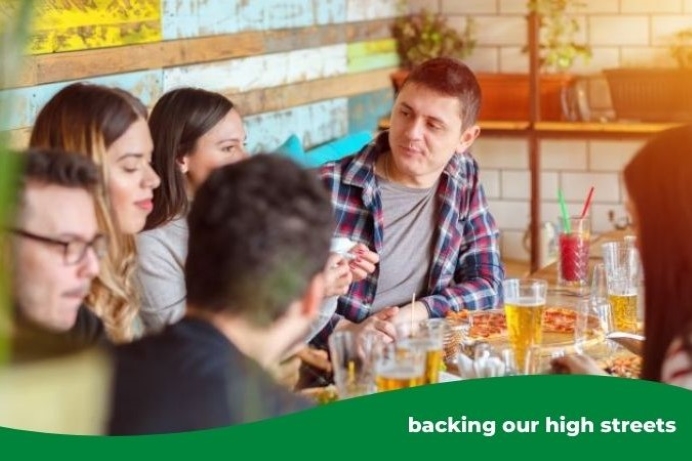On 23 April it will be the 40th anniversary of the events in Southall in 1979 that were later to be called ‘the Southall riots’. Borough archivist Dr Jonathan Oates looks back at how it all unfolded and how it was reported at the time.
In 1979 there was a general election approaching and political parties, as always, needed public halls in which to hold their election meetings. Regardless of their views, legally appointed parties cannot be refused such accommodation.
The National Front booked to hold a meeting at Southall Town Hall on 23 April 1979. This was clearly meant to be a provocative gesture and one which it presumably hoped would gain it maximum publicity. The population of Southall contained a very high number of people from the Indian subcontinent and, to a lesser extent, from Africa and the West Indies. Given the policies of the National Front were opposed to immigration and in favour of repatriation, this was throwing down a deliberate challenge to many residents. The timing – on St George’s day – was also surely significant too in that it was a nationalist party and this was England’s patron saint’s day. The subject is still a highly emotive one both among residents and those who took part, whether protestors or police officers.
Although the National Front was legally within its rights and Ealing Council acted within the letter of the law, many were troubled. Some contacted the council and asked them to retract their consent, though this would have been illegal. A telegram was even sent to the Prime Minister, James Callaghan, and Home Secretary to intervene in the interests of peace as they were concerned about the possible repercussions. The chairman of the Commission for Racial Equality was also contacted. Callaghan later said that the law would have had to have been changed to disallow such and he was not prepared to countenance this just yet. Yet both the Ealing Labour Party and the chairman of Ealing Council did not heed the warnings and stated that under the Representation of the People Act they were obliged to let political parties use public halls for electoral purposes. The National Front said that its meeting was a public meeting but that only 20 non-party members at most would be able to attend (it was a small room).
The police cannot ban public meetings no matter how much dis

order they might lead to, though bans or re-routing of meetings and processions are permissible with the Home Secretary’s approval. The holding of public meetings, as said, is the role of the local authority. It is the task of the police to ensure that they occur peacefully. On the day before the meeting there was a peaceful sit-in and local police tried to persuade the protestors that that was all that was needed to register their protest and that a large turn out on the next day might be dangerous, but this advice went unheeded. It seems that there were differences of opinion between the older and the younger residents. Therefore, police took the possibility of disorder seriously and deployed in large numbers, about 2,750 officers, in the town centre near to the town hall.

Various groups of people began to gather near the town hall from about noon on that Monday. There was disagreement among the protestors about where they should march and so they split into two groups. There was also a stewards’ meeting about tactics attended by the younger protestors. The police also began to arrive, many coming by coaches. At about 1pm there were 150 protestors near the town hall. They were moved on and one man who had a knife was arrested.
At 3pm there were several hundred protestors with placards. Some were persuaded to move along the Uxbridge Road. Some minor scuffling began as the police were attacked by placards and poles. A bus was attacked and boarded and police arrested selected individuals and put them under arrest in vans.
At 4pm a number of roads were cordoned off by police. This was done in order to limit the violence that had already occurred but also increased the frustrations of some among the crowd. Often, it should be said, relations between front line protestors and police were amicable enough.
One officer recalled, ‘a barrack room lawyer confronting me asking me on what authority I was able to stop him going through the cordon. I was completely lost and said ‘Because I have asked you politely not to’. The crowd suddenly unexpectedly shouted ‘Leave him alone! He did say please’ and that really was the high point of my part in the early riot’. However, 20 yards behind the front lines were missile throwers. Youths had made bombs and bottles and bricks were supplied to those who wanted to use them.

Rather than keeping the peace, the police cordons may have had the opposite effect of heightening tension as it provoked some in the crowd to violence. Violence began to escalate as the crowd began to throw bottles and stones as police took shelter behind riot shields. This was at about 6.20pm when between 500-2,000 protestors tried to break the police cordon on the High Street and near the town hall. One officer was stabbed and others were injured. A bus carrying police was attacked.
This was probably the worst part of the violence. Some officers were in danger of being cut off and others used riot shields. It was then that mounted police were used to disperse the crowds.

Those protesting at the election meeting numbered perhaps 3,000 and were mostly from Southall, though some came from elsewhere in London and from other nearby towns such as Slough. There was debate afterwards as to the composition of the crowd, whether it was a wholly local protest or not. To an extent both are true; there were many local people present. But there were others from elsewhere; Tariq Ali, for one, and Clement Blair Peach for another, who belonged to Far Left groups and took up the Southall cause as part of a wider struggle. Many had come for a peaceful protest and sat down at Southall Broadway. An Ealing resident complained that he and his wife were verbally abused by police officers and were even threatened with arrest.
Arrests were made from a house in Park View Road, which was the headquarters of People’s Unite Community Affairs. This was because police officers entering this road had been attacked by missile throwers based in this house. When they entered it, they found that it was partly barricaded and more items were thrown at them. They arrested 70 people at or near this location.

There was other activity elsewhere. Shops in the Broadway were attacked by some of the crowd and other youths climbed on to shop roof tops. ‘A large group of youths’ threw stones from Alexandra and Beechcroft Avenues at the police at about 8pm and one officer’s jaw was fractured. The police were reinforced and then cleared the roads of the stone throwers.
The National Front, whose meeting had sparked off these events, may well have been forgotten. Between 7pm and 7.25pm, its members began to arrive at the town hall. Some were insulted by protestors who were on the roof of a nearby shop. They could not be stopped because there was a police cordon between them and the demonstrators. Once it was known that the meeting was under way, there was little point in being around any more and so some of the crowds began to disperse.
The meeting took place in a very small room in the town hall, one usually used for wedding receptions and parties. The speakers were the party leader and candidates in the forthcoming election and spoke of their policies. Very few people were actually at the meeting; about 40 party members, three journalists and a few others. The meeting was over by 9.30pm. Some of the National Front members appeared on the steps of the town hall and made insulting gestures, and shouted: ‘The reds, the reds, we’ve got to get rid of the reds’.
Although free speech had been upheld, it had been at a cost, with 340 arrests having been made, mainly for carrying offensive weapons, for attacking the police and for public disorder; 36 police officers had been injured and 21 needed treatment in Ealing Hospital, as did 24 demonstrators. A National Front supporter was found beaten up near Southall railway station.
There was also a great deal of damage to shops in Southall, perhaps resulting in £30,000 worth of damage. Vehicles and street furniture was also destroyed and damaged. The Chamber of Commerce claimed that the council and the police had an obligation under law to reimburse those whose livelihoods had been damaged, but the council claimed that this was only discretionary, but they agreed to assist with loans.
Worse was to come. Blair Peach died of a head wound in Ealing Hospital just after midnight on 24 April. He was a New Zealand teacher, born in 1946, who worked at a school in Hackney. He was politically active, being a member of the Socialist Workers’ Party and the Anti-Nazi League; both groups being prominently involved in Southall on the 23rd. His supporters claimed that he had been on his way home when he was attacked. He seems to have been moved to a house nearby, 71 Orchard Avenue, and an ambulance called from there. The blow which had killed him was not from a police truncheon, a riot shield, a police radio or from the weapons later found in a police station. It may have been a lead-filled rubber cosh. On the other hand, 10 witnesses, some of whom were members of the Anti-Nazi league, the Socialist Workers’ Party and the Southall Rights movement, claimed to have seen him being attacked by the police and suspicion fell on a group of six Special Police Group officers.
These were Inspector Alan Murray and constables White, Freestone, Lake, Richardson and Scottow of the 200-man SPG, a cross divisional force. They were named in a document produced by Commander John Cass of Scotland Yard and presented to the DPP, some of which seems to have its way into the press. Wanted posters were widely distributed to the effect that these half dozen were guilty. The politician Ken Livingstone also claimed he knew the names of two officers, one of which was the killer but he refused to say who they were. Murray resigned from the force in the following year. In an interview in 2009 he denied any wrong doing and said he had not seen any of his men attack Peach, though added that it was a very chaotic situation.
However, the witnesses initially refused to be interviewed by the police and suggested that a supermarket trolley killed their friend. They told other witnesses to say nothing to the police until they had a friendly solicitor present. They also agreed to conceal the presence of a witness. They were happy to present a united front to TV and other journalists, that is to say Peach was on his way home and was attacked by several officers, whilst running away and much blood was spilt.
When they were finally interviewed by the police, their stories differed and did not match the findings of the pathologists’ post mortems. These found that he had no defence injuries, nor that he fell when hit. There had been a single blow which had resulted in a closed head injury, which rendered him unconscious but no sign of an external wound. A lengthy inquest which took place in 1980 concluded that his death had been a result of misadventure and this was condemned by some commentators, including his family. Evidence given by the eye witnesses seemed unbelievable to jurors and while police witnesses were at odds with one another, too, there seemed to be no evidence of a conspiracy.
There were various groups set up titled Friends of Blair Peach and the New Zealand Friends of Blair Peach and there have been marches on the anniversaries of his death and his name became a synonym for police brutality. Prominent in these were his brother Roy, a New Zealand solicitor, and also Celia Stubbs, a close friend. No one has ever been charged with his death, though in recent years the Metropolitan Police has said that one of its officers dealt the fatal blow, but this man has never been identified. Ealing Council named one of its Southall primary schools after Blair Peach.
Two years after his death, a friend of his, Janice Anderson, who he had stayed with on the evening of the 22nd, claimed that he told her that he thought he had been followed by two men in a white car which had later parked near his friend’s home. No more details are known and it seems unclear why this information was withheld for so long.
Community relations with the police were also damaged because many saw the police as the aggressors. There was an Independent Police Inquiry set up to investigate what happened, but there was also another report commissioned by the NCCL led by Professor Dummet, well known for his anti-racism campaigning, as well as trade unionists, liberal clergy and Labour MPs. None of these people had been involved in the demonstration, though all were sympathetic to it. Although this report did not absolve the protestors of committing any violence, it deemed that the police had been excessive in their use of force.
There were many different voices raised in public about the riot; from politicians of all persuasions, moderate and otherwise, Left and Right, and police spokesmen, from people near and far, from those who were there and those who were not, from journalists and many others.
To this date no one has been charged with the killing of Blair Peach. There has never been a public inquiry and, despite frequent calls for such, for example in 1999, these were turned down, apparently because of the problem of the time lapse. Scotland Yard released the Cass report online in 2010, concluding, but not identifying which, police officers may have killed Peach. His family reached an out of court settlement with the Metropolitan Police in 1989.
Photographs from Ealing Gazette in 1979.
